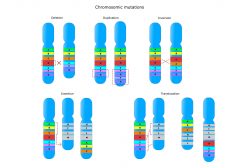Definition
noun, plural: chromosomal inversions
A chromosomal aberration wherein a segment of a chromosome is reversed end-to-end
Supplement
Chromosomal inversion is a type of a large-scale mutation. Mutation is a change in the nucleotide sequence of a gene or a chromosome. It is a large-scale type of mutation since it involves several nucleotides of a gene within a large chromosomal region.
Chromosomal inversions are a rearrangement within the chromosome. They result from a double break in a segment of the chromosome, with end for end rotation of the fragment between the fracture lines, and re-fusion of the fragments. This leads to the reversal of the order of genes in that segment.
There are of two types of chromosomal inversions: pericentric inversion and paracentric inversion. A pericentric inversion is a chromosomal inversion that includes the centromere whereas a paracentric inversion is one that does not include the centromere. Furthermore, in pericentric inversion, the break point occurs in each arm. In paracentric inversion, both breaks occur in one arm of the chromosome.
Detection of chromosomal inversions is possible through cytogenetic techniques and genetic analysis.
Chromosomal inversions though do not always lead to abnormalities provided that the rearrangement leads to no extra or missing DNA. When they do lead to chromosomal imbalance, such as increased abnormal chromatids from crossing-overs, they could then lead to chromosomal aberrations. An example of such condition in humans is the chromosomal inversion involving chromosome 9, i.e. inv(9)(p12q13).
See also:
Dictionary > Chromosomal inversion

